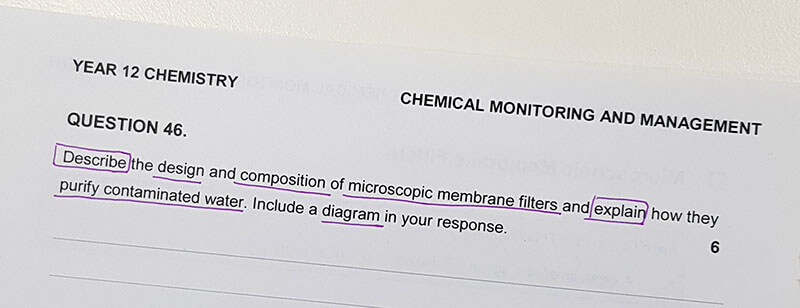Year 12 Chemistry
Boost your Chemistry marks and confidence with structured courses online or on-campus.
Learning methods available
Select a year to see available courses
In this article, Dr Michelle Wong gives her top 5 tips to help you ace your HSC trials.

Join 75,893 students who already have a head start.
"*" indicates required fields
You might also like
You may have spent hours memorising the dot points for your HSC Chemistry exam and practising mole calculations… but how’s your exam technique? Lots of students know the content back to front and inside out, but they still manage to lose marks because they haven’t done what the markers want. Don’t be that guy! Here are the top 5 tips to make sure you max out your Chemistry Trial marks.
Chemistry isn’t English, but Chemistry exam questions can still be a few sentences long. It’s really easy to miss an important word or forget to mention something important, especially when you’re writing a long response.
What to do:
Underline all the keywords in the question. Put a box around the keyword. When you’ve finished writing your response, check that you’ve addressed each underlined word.
At the end of the exam, if you have time left over, go back and check that you’ve addressed all the parts for each question.

Start HSC Chem confidently
Expert teachers, comprehensive resources, one-to-one help! Learn from home with Matrix+ Online.
Long responses can be hard to write, especially if you picked Chemistry because you thought you could avoid writing essays! It’s important to plan your answers before writing them, for several reasons:
Plans for long responses should be quite comprehensive – three-word plans won’t be very useful for a 6-7 mark question.
What to do:
At the beginning of the writing time, go through and analyse the questions in the paper. For any questions that are 4 or more marks, construct a detailed dot point plan. Then start writing your answers.

Rounding a number makes it less accurate.
If you round off a number, then perform more mathematical operations on it, your answer will get less and less accurate.
Take this mole calculation, for example:
25.0 mL of 0.353 M hydrochloric acid required 21.4 mL of sodium hydroxide solution to neutralise. What was the concentration of the sodium hydroxide?
HCl(aq) + NaOH(aq) → NaCl(aq) + H2O(aq)
Without rounding |
With rounding |
| n(HCl) = 0.353 x 0.025 = 8.825 x 10-3 mol
n(NaOH) = 8.825 x 10-3 mol c(NaOH) = (8.825 x 10-3) / 0.0214 = 0.412 M (3 s.f.) |
n(HCl) = 0.353 x 0.025 = 8.825 x 10-3 mol = 8.83 x 10-3 mol (3 s.f.)
n(NaOH) = 8.83 x 10-3 mol (3 sig fig) c(NaOH) = (8.83 x 10-3) / 0.0214 = 0.413 M (3 s.f.) |
This is particularly important in pH calculations, where taking the log10 of a rounded number can make your answer very different!
What to do:
Include 2 – 3 more digits in the intermediate calculation steps than you’ll eventually need in your final answer. You can also use your calculator’s storage functions to keep the unrounded numbers, but it’s a good idea to write down the unrounded numbers every once in a while in your working so it’s easier to check your working later.
Some schools will deduct a whole mark if you leave out a single subscript in your balanced chemical equation! It feels really unfair, but in some situations, it’s very important – you can stand safely next to a large beaker of aqueous HCl, but you don’t want to inhale a large quantity of HCl(g)!

Take note of hints in the question about what state the substance is in:
In general, the states you’ll give in equations for the HSC are for the substances at 25 °C and 100 kPa.
If you can’t work out a particular state, think back to the properties of substances at room temperature that you learned in Year 11. For example, ionic compounds tend to have high melting points, so they are almost always solid or aqueous at room temperature. There are only 2 liquid elements at room temperature and 11 gases (can you remember them?).
What to do:
Make a habit of writing the relevant subscript immediately after you write each term in the chemical equation. You might think that you’ll go back and add subscripts later… but it’s very easy to forget.
Chemistry skills aren’t clearly in the module dot points, but there are always a substantial number of questions in Chemistry exams that test your ability to “science well”.
Make sure you’re familiar with:
Written by Michelle Wong
Michelle is the Senior Chemistry Teacher at Matrix Education, and has been tutoring Chemistry and Mathematics for over 15 years.© Matrix Education and www.matrix.edu.au, 2023. Unauthorised use and/or duplication of this material without express and written permission from this site’s author and/or owner is strictly prohibited. Excerpts and links may be used, provided that full and clear credit is given to Matrix Education and www.matrix.edu.au with appropriate and specific direction to the original content.